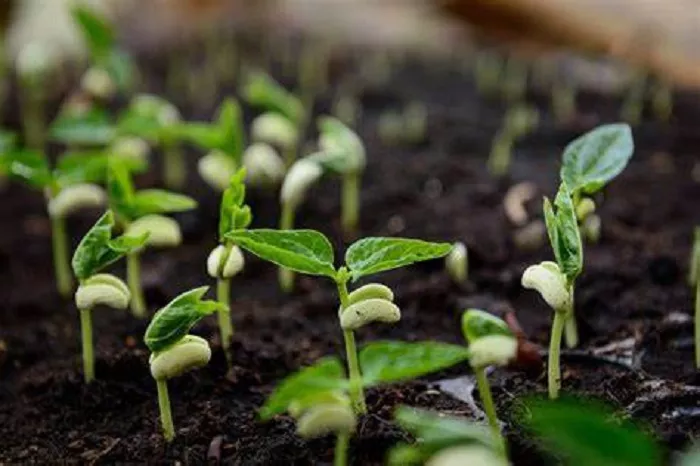The humble bean plant is a marvel of nature, offering both sustenance and beauty. From the moment a seed is sown to the time it bears its bounty, the journey of a bean plant is a testament to the wonders of plant life. Whether you are a seasoned gardener or a novice with a green thumb, understanding the growth process of bean plants can enhance your gardening experience and yield a rewarding harvest.
The Life Cycle of a Bean Plant
Germination: The First Step
Bean plants begin their journey as seeds, each one a tiny package of potential. When planted in well-prepared soil, the seed absorbs water and swells, triggering the germination process. Within a few days, a small root emerges, burrowing downward to anchor the plant and absorb nutrients. Soon after, a shoot pushes its way through the soil, reaching for the light. This initial stage is critical, as it sets the foundation for the plant’s growth. Providing the right conditions, such as warm temperatures and consistent moisture, is essential to ensure successful germination.
Seedling Development: Taking Root
As the shoot breaks through the soil, it transforms into a young seedling. At this stage, the plant focuses on developing its first set of true leaves, which are crucial for photosynthesis. These leaves capture sunlight and convert it into energy, fueling the plant’s growth. Meanwhile, the root system continues to expand, delving deeper into the soil to access water and nutrients. It is important to protect seedlings from harsh weather and pests during this vulnerable period. Regular watering and light fertilization can help support healthy development.
Vine Growth and Flowering
Depending on the variety, bean plants may grow as bush beans or pole beans. Bush beans remain relatively compact, while pole beans develop long vines that require support. As the plant matures, it enters the flowering stage, producing delicate blossoms that attract pollinators. These flowers are essential for fruit production, as they must be pollinated to form bean pods. Providing proper support for climbing varieties and ensuring adequate spacing for bush beans can optimize flowering and subsequent pod development.
Pod Formation and Maturation
Once pollination occurs, bean pods begin to form. These pods house the developing seeds, which will eventually become the beans we harvest. The growth rate of the pods depends on factors such as sunlight, temperature, and soil fertility. Regular watering is crucial during this stage to prevent the pods from drying out. As the pods mature, they change color and texture, indicating readiness for harvest. Timely harvesting not only ensures tender and flavorful beans but also encourages the plant to produce more pods.
Cultivation Tips for Healthy Bean Plants
Soil Preparation
Bean plants thrive in well-drained, nutrient-rich soil. Before planting, it is advisable to amend the soil with organic matter such as compost or well-rotted manure. This not only improves soil structure but also provides essential nutrients. A pH level between 6.0 and 7.0 is ideal for most bean varieties. Testing the soil and making necessary adjustments can help create the optimal environment for growth.
Planting and Spacing
Proper planting techniques are vital for the success of bean plants. Sow seeds directly into the garden bed, as beans do not transplant well. For bush beans, space the seeds about 2 to 4 inches apart in rows that are 18 to 24 inches apart. Pole beans, on the other hand, should be planted in hills or rows with support structures such as trellises or poles. Planting in succession every two weeks can ensure a continuous harvest throughout the growing season.
Watering and Fertilization
Consistent watering is key to healthy bean plant growth. Beans require about 1 inch of water per week, either from rainfall or irrigation. It is important to water deeply and avoid overhead watering, as wet foliage can lead to fungal diseases. Fertilizing with a balanced, slow-release fertilizer at planting time can provide the necessary nutrients. However, avoid over-fertilizing, as excessive nitrogen can lead to lush foliage but fewer pods.
Pest and Disease Management
Bean plants can be susceptible to pests such as aphids, beetles, and bean weevils. Regular monitoring and early intervention can prevent infestations. Natural pest control methods, such as introducing beneficial insects or using insecticidal soap, are preferable to chemical pesticides. Diseases like powdery mildew and rust can also affect bean plants. Ensuring good air circulation, proper spacing, and removing infected plant material can help minimize disease spread.
Harvesting and Beyond
Harvest Timing
Knowing when to harvest beans is crucial for flavor and texture. For snap beans, harvest when the pods are tender and about the thickness of a pencil. Shell beans should be harvested when the pods are plump but not overly mature. Over-mature beans can become tough and fibrous. Regular harvesting encourages the plant to continue producing more pods, extending the harvest period.
Post-Harvest Care
After harvesting, beans can be stored in a cool, dry place or refrigerated for short-term use. For long-term storage, beans can be dried or frozen. Drying beans involves spreading them out in a well-ventilated area and allowing them to dry completely before storing in airtight containers. Freezing beans requires blanching them briefly in boiling water, then cooling and freezing them in freezer-safe bags.
Companion Planting and Crop Rotation
Bean plants can benefit from companion planting with other vegetables. For example, planting beans with corn can provide natural support for climbing varieties, while marigolds can help deter pests. Crop rotation is also essential to prevent soil-borne diseases and nutrient depletion. Avoid planting beans in the same spot for more than two consecutive years and rotate with other crops such as tomatoes or cucumbers.
Conclusion
The growth of bean plants is a fascinating process that showcases the intricate balance of nature. From germination to harvest, each stage requires attention and care. By understanding the needs of bean plants and providing the right conditions, gardeners can enjoy a bountiful harvest. Whether grown for fresh eating or long-term storage, beans are a versatile and rewarding addition to any garden.


